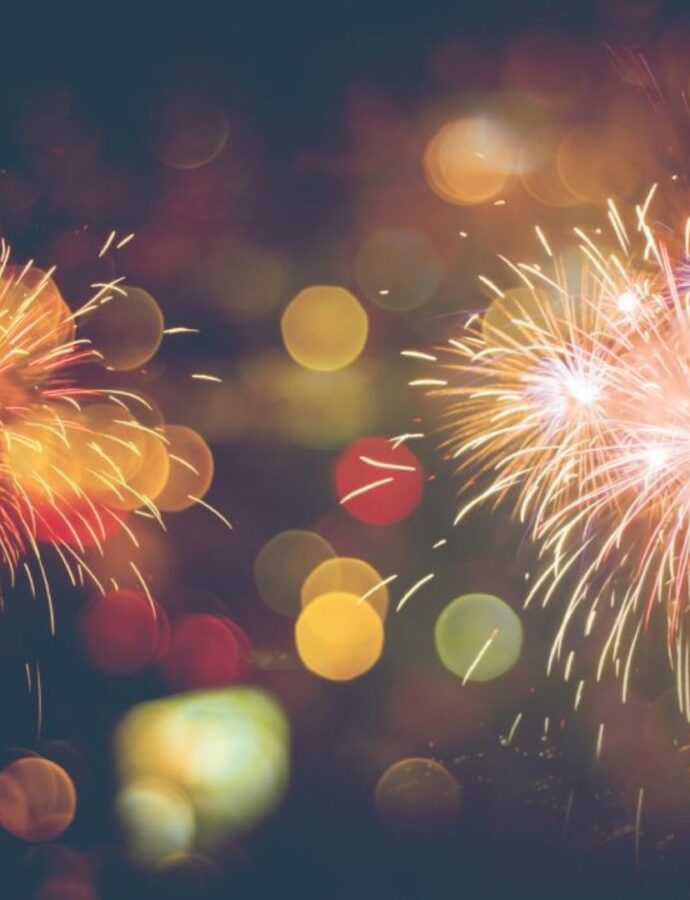
“Man in his normal state had no need for instruction in breathing. Like the lower animal and the child, he breathed naturally and properly, as nature intended him to do, but civilization has changed him in this and other respects. He has contracted improper methods and attitudes of walking, standing, and sitting, which have robbed him of his birthright of natural and correct breathing… The Yogi knows that by controlled breathing he may not only cure disease in himself and others, but also practically do away with fear and worry and the baser emotions.”
– From the book, Science of Breath by Yogi Ramacharaka
Breath Is More Than Life
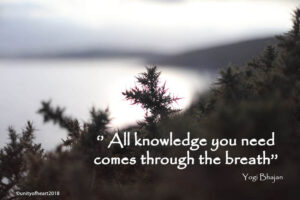 For thousands of years, yogis have realized the profound relationship between an individual’s mental & physical state and breathing. When we are nervous, frightened, or angry, our breathing is immediately affected, usually becoming short, fast, and shallow. Conversely, when we are relaxed and calm, our breathing is long, slow, and deep.
For thousands of years, yogis have realized the profound relationship between an individual’s mental & physical state and breathing. When we are nervous, frightened, or angry, our breathing is immediately affected, usually becoming short, fast, and shallow. Conversely, when we are relaxed and calm, our breathing is long, slow, and deep.
Our breath has a profound impact on our physiological state. Using breath to address the nervous system’s imbalances is a beneficial and powerful way to cultivate balance in the body. For example, extending the length of your exhale beyond the length of your inhale stimulates your parasympathetic nervous system (the “calm down” mechanism in your body). On the other hand, a longer inhale has a stimulating effect. Depending on how you feel (overly stimulated or overly inert), you can manipulate the breath to bring you closer to balance.
 The book, Asana Pranayama Mudra Bandha describes how breathing is related to lifespan. Ancient yogis used to study nature in great detail. They noticed that animals with a slow breath rate, such as elephants, tortoises, and pythons, have long life spans. Animals such as birds, dogs, and rabbits, have faster breathing rates and shorter life spans. They concluded humans also benefit from slow breathing to increase lifespan. One reason for this is the relationship between respiration and the heart. A slow and rhythmic breath rate nourishes the heart. Studies have also found that deep, diaphragmatic breathing can slow your heart rate and reduce blood pressure.
The book, Asana Pranayama Mudra Bandha describes how breathing is related to lifespan. Ancient yogis used to study nature in great detail. They noticed that animals with a slow breath rate, such as elephants, tortoises, and pythons, have long life spans. Animals such as birds, dogs, and rabbits, have faster breathing rates and shorter life spans. They concluded humans also benefit from slow breathing to increase lifespan. One reason for this is the relationship between respiration and the heart. A slow and rhythmic breath rate nourishes the heart. Studies have also found that deep, diaphragmatic breathing can slow your heart rate and reduce blood pressure.
Breathing is the only bodily function you can perform consciously or unconsciously. The act of breathing can be completely voluntary or involuntary. The brainstem is responsible for controlling our unconscious breathing rate. The brain’s cortex takes over when we make breathing a conscious process. The differentiation between voluntary and automatic breathing is that automatic breathing requires no attention to maintain, whereas voluntary breathing involves a significant amount of focus. Changing our breathing patterns can begin to slow down our mind’s activity and alter our physical and mental states.
Prana
 Prana can be tricky to explain and understand because we cannot see, taste, hear, or smell it. Prana can be felt, however, and there are over 3,000 years of references to Prana outside of the yoga tradition. References to Prana are made in the Chinese principle of chi, ancient Roman anima, ancient Greece pneuma, ruh of the Islamic tradition, and ruah of the Hebrew tradition.
Prana can be tricky to explain and understand because we cannot see, taste, hear, or smell it. Prana can be felt, however, and there are over 3,000 years of references to Prana outside of the yoga tradition. References to Prana are made in the Chinese principle of chi, ancient Roman anima, ancient Greece pneuma, ruh of the Islamic tradition, and ruah of the Hebrew tradition.
Prana is life force energy, found in all things. I distinctly remember experiencing the real effects of Prana after 2-weeks of regular morning breathing exercises (Pranayama) during my last teacher training in India. I came out of the meditation room and instantly noticed my sense of sight had been heightened. I felt alertness coupled with a feeling of calm. My energy levels were well balanced and I felt clear.
Prana’s quantity, quality, and how it flows through the body determine one’s state of mind. If the Prana level is high, and its flow is continuous, smooth, and steady, the mind remains calm and positive. However, due to a lack of knowledge and attention to one’s breath, Prana may become blocked. As a result, one experiences increased worries, fear, uncertainty, tensions, conflict, and other negative qualities.
All systems of the body are taken care of when Prana is cared for properly. One way to increase Prana is through the practice of Pranayama.
Pranayama (Breath Control)
Pranayama= Immunity, health, and peace right under your nose.
 Pranayama is the practice of breath control. One purpose of Pranayama, is to enhance Prana. The breath is the vehicle for Prana. When we breathe in, we take in Prana. When we expand the breath and improve its quality, we grow and enhance the quality of this vital life force within and around us.
Pranayama is the practice of breath control. One purpose of Pranayama, is to enhance Prana. The breath is the vehicle for Prana. When we breathe in, we take in Prana. When we expand the breath and improve its quality, we grow and enhance the quality of this vital life force within and around us.
Another purpose of Pranayama is to establish correct breathing. Most people use only a small portion of their lung capacity while breathing. Incorrect and shallow breathing can deprive the body of oxygen, which is essential to maintain good health. Pranayama helps to reestablish healthy breathing patterns and the natural rhythms of the body and mind.
Research Proven Benefits of Pranayama:
- Keeps your lungs healthy
- Improves cardiovascular health
- Boosts Immunity
- Helps to clear blockages in the nasal cavity and sinuses
- Aids in detoxification of the body and mind
- Improves Concentration
- Helps to treat sleep disorders
- Reduces stress
- Increases grey matter of the brain
- Improves clarity
- Improves Digestion
- Keeps your skin healthy
- Aids in weight loss
- Reduces the activity of your mind
You can read more about this research here
Blemishes Of The Mind
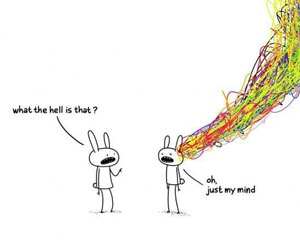 Pranayama controls two types of blemishes of the mind:
Pranayama controls two types of blemishes of the mind:
- One blemish of the mind is an overactive mind, which manifests as restlessness, agitation, anxiety, stress, & anger. A restless mind can also result in too many attachments to material objects, a tendency to live in the future, lack of focus, obsessive behaviors, and poor habits.
- A second blemish is an underactive or sluggish mind, which results in laziness, lethargy, depression, living in the past, compulsive thinking, and addictions. Pranayama helps combat these blemishes resulting in a clear, focused, and energized body and mind.
There are three categories of Pranayama that can be performed to combat the above blemishes of the mind.
- Revitalizing Pranayama: Techniques where you work to expand the body’s lung capacity and energy. These practices help to remediate the second type of blemishes.
- Balancing Pranayama: Helps with anxiety and concentration. These techniques help to combat both of the above blemishes of the mind.
- Relaxing Pranayama: Cools the various parts of the body, relaxing them and giving them rest. These exercises remediate the first type of blemishes of the mind.
Putting Pranayama Into Practice
Three-Part-Breathing (as demonstrated by Joe)
Each morning I begin my day with a breathing exercise called Three-Part-Breathing. It energizes my body, while bringing my mind some clarity. This technique also helps to rid my body of any anxiety that I carried with me into the start of my day. Three-Part-Breathing is suitable for beginners. This exercise only takes about 10 minutes to complete and is well worth it because of its many benefits.
Benefits of 3-Part-Breathing
Three-Part Breathing teaches you how to breathe fully and completely. Ineffective breathing is common in today’s modern world—lifestyle factors such as long periods of sitting or driving result in shallow, or chest, breathing. Shallow breathing does not allow for fresh oxygen to enter the lower chest, lungs, and diaphragm. Incorrect breathing can result in a lack of oxygen to your blood vessels, which can strain the heart and lungs.
Some of the benefits of Three-Part Breathing include:
- Calms the mind and body, reducing stress and anxiety.
- Facilitates full and complete breathing patterns
- Increases oxygen supply to the blood.
- Helps keep the lungs healthy.
- Releases muscular tension.
- Prepares for deeper meditation.
Steps of 3-Part- Breathing
There are different ways that Three-Part-Breathing can be performed. I am going to describe it using three different hand positions for each step. You do not have to incorporate these into your practice. You can instead allow your hands to rest on your lap. I prefer to move my upper body’s positioning with each step because it improves my posture and allows more air to enter my belly, rib cage, and chest. If sitting is uncomfortable, this exercise can also be done on your back.
Steps of Three-Part Breathing
- Step 1: Come to a comfortable sitting position. Make sure your spine is long, and your body is relaxed. Close your eyes and breathe in and out through your nose. Begin to focus your mind on your inhales and exhales.
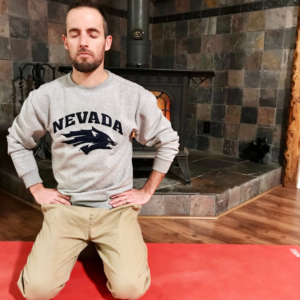 Step 2: Place your hands on your waist with your elbows wide and shoulders relaxed. Inhale through your nose for a count of 4 slow breaths. Allow your belly to expand gently as the breath moves into your lungs. Then slowly exhale through your nose for a count of 6. As you exhale, draw your navel toward your spine. Allow as much air as possible to escape from your lungs. Repeat this cycle for 5-8 rounds. Allow your hands to rest on your lap for a couple of breaths after you complete your last round.
Step 2: Place your hands on your waist with your elbows wide and shoulders relaxed. Inhale through your nose for a count of 4 slow breaths. Allow your belly to expand gently as the breath moves into your lungs. Then slowly exhale through your nose for a count of 6. As you exhale, draw your navel toward your spine. Allow as much air as possible to escape from your lungs. Repeat this cycle for 5-8 rounds. Allow your hands to rest on your lap for a couple of breaths after you complete your last round.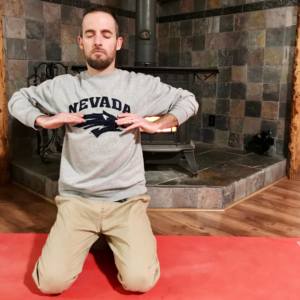 Step 3: Place your hands just under your armpits. Palms face down with your elbows wide and shoulders relaxed. Here we will add a step. Slowly, inhale through the nose for a count of 4. Allow your belly and rib cage to expand. Lightly exhale through the nose for a count of 6. Gently press the air out of your rib cage and belly until they’re empty. Repeat this step for the same number of rounds as step 2 (5-8 rounds). Allow your hands to rest on your lap for a couple of breaths after you complete your last round.
Step 3: Place your hands just under your armpits. Palms face down with your elbows wide and shoulders relaxed. Here we will add a step. Slowly, inhale through the nose for a count of 4. Allow your belly and rib cage to expand. Lightly exhale through the nose for a count of 6. Gently press the air out of your rib cage and belly until they’re empty. Repeat this step for the same number of rounds as step 2 (5-8 rounds). Allow your hands to rest on your lap for a couple of breaths after you complete your last round. Step 4: Place the palms of your hands on your upper back, close to your shoulder blades. Your elbows face up toward the ceiling and slightly inward. Soften your shoulders. *** This may not be very comfortable at first (or ever). Just remember you won’t be here forever. In this step, we will add on slightly. Inhale through the nose for a slow count of 4. Allow your belly, rib cage, and chest to expand. Slowly exhale out for a count of 6. Release the air from the upper chest, rib cage, then belly. Repeat this cycle for the same number of rounds as steps 2-3 (5-8 rounds). Then take a few regular cycles of breath in and out of your nose. Notice any subtle differences in your body or mind.
Step 4: Place the palms of your hands on your upper back, close to your shoulder blades. Your elbows face up toward the ceiling and slightly inward. Soften your shoulders. *** This may not be very comfortable at first (or ever). Just remember you won’t be here forever. In this step, we will add on slightly. Inhale through the nose for a slow count of 4. Allow your belly, rib cage, and chest to expand. Slowly exhale out for a count of 6. Release the air from the upper chest, rib cage, then belly. Repeat this cycle for the same number of rounds as steps 2-3 (5-8 rounds). Then take a few regular cycles of breath in and out of your nose. Notice any subtle differences in your body or mind.
Change Your Breath, Change Your Mind
Often times we take our breath for granted. I am amazed that we all have been given this gift, right under our nose, that we can access at any time to change our physical and mental states. When you feel like your low on energy, having difficulty focusing, upset with the world, or feeling blue, try shifting how you breath to shift how you feel. I promise it works. All you have to do is sit down, close your eyes, and practice conscious breathing. Good luck!
More on How you can Put The Practice of Pranayama Into Practice
If you are interested in exploring various breathing techniques, I recommend a course from Udemy called “Breath Is Life.” Right now you can get it for $14.99. You can find this particular course here.
Udemy has special offers for courses at different times so you never have to purchase a course for full price. Sometimes you just have to wait to purchase the course until it goes on sale.

